History 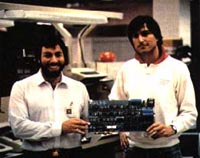
Steven Wozniak and Steven Jobs had been friends in high school. They had both been interested in electronics, and both had been perceived as outsiders. They kept in touch after graduation, and both ended up dropping out of school and getting jobs working for companies in Silicon Valley. (Woz for Hewlett-Packard, Jobs for Atari)
Wozniak had been dabbling in computer-design for some time when, in 1976, he designed what would become the Apple I. Jobs, who had an eye for the future, insisted that he and Wozniak try to sell the machine, and on April 1, 1976, Apple Computer was born.
Hobbyists did not take the Apple I very seriously, and Apple did not begin to take off until 1977, when the Apple II debuted at a local computer trade show. The first personal computer to come in a plastic case and include color graphics, the Apple II was an impressive machine. Orders for Apple machines were multiplied by several times after its introduction. And with the introduction in early '78 of the Apple Disk II, the most inexpensive, easy to use floppy drive ever (at the time), Apple sales further increased.
With the increase in sales, however, came an increase in company size, and by 1980, when the Apple III was released, Apple had several thousand employees, and was beginning to sell computers abroad. Apple had taken on a number of more experienced mid-level managers and, more importantly, several new investors, who opted to take seats on the board of directors. Older, more conservative men, the new directors made sure that Apple became a "real company," much to the dismay of many of its original employees.
In 1981, things got a bit more difficult. A saturated market made it more difficult to sell computers, and in February. Apple was forced to lay off 40 employees. Wozniak was injured in a plane crash. He took a leave of absence and returned only briefly. Jobs became chairman of Apple computer in March.
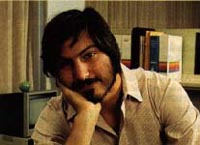 Following the historic visit to Xerox PARC in
1979, Jobs and several otherengineers began to
develop the Lisa, which wouldredefine personal
computing. Jobs, however, proved to be a poor
project manager,and was taken off the Lisa by
Mike Markkula, president of Apple, and one of
themajor stockholders. Jobs, who owned only
11% of Apple, decided to take oversomeone
else's project, and began working with the Macintosh--whichhad started as a
$500 personal computer. Jobs made sure it was much more.
Following the historic visit to Xerox PARC in
1979, Jobs and several otherengineers began to
develop the Lisa, which wouldredefine personal
computing. Jobs, however, proved to be a poor
project manager,and was taken off the Lisa by
Mike Markkula, president of Apple, and one of
themajor stockholders. Jobs, who owned only
11% of Apple, decided to take oversomeone
else's project, and began working with the Macintosh--whichhad started as a
$500 personal computer. Jobs made sure it was much more.
In 1981, IBM released its first PC. With the power of Big Blue behind it, the PCquickly began to dominate the playing field. Jobs' team would have to work veryquickly if they hoped to compete with IBM in the personal computer market. Jobsbegan to realize that Apple would have to become a "grown-up" company,and realized he was not the man for the job.
In early 1983, Jobs began to court John Sculley, then president of Pepsi-Cola.In April, he was successful, and Sculley became president and CEO of Apple.
Jobs believed Sculley would help Apple "grow up," but had no idea howright he would turn out to be. Eventually, it cost him his job.
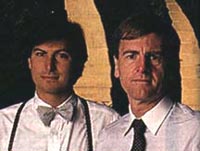 Although a successful businessman, it soon
became clear that Sculley did notknow much
about the computer industry. He and Jobs were
at odds almostimmediately. As the
announcement of the Macintoshdrew closer,
Jobs went into hyperdrive. He worked hard to
get developers towrite programs for the
upcoming machine--Jobs had realized that the
Mac wouldultimately be made or broken by the
software industry.
Although a successful businessman, it soon
became clear that Sculley did notknow much
about the computer industry. He and Jobs were
at odds almostimmediately. As the
announcement of the Macintoshdrew closer,
Jobs went into hyperdrive. He worked hard to
get developers towrite programs for the
upcoming machine--Jobs had realized that the
Mac wouldultimately be made or broken by the
software industry.
On January 22nd, 1984, during the third quarter of the Super Bowl, Apple airedits infamous 60 secondcommercial introducing the Macintosh. Directed by Ridley Scott, theOrwellian scene depicted the IBM world being shattered by a new machine.Initially, the Mac sold very well, but by Christmas of 1984, people werebecoming fed up with its small amount of RAM, and lack of hard driveconnectivity.
It was around the beginning of 1985 that Jobs and Sculley began to argue.Sculley believed Jobs was dangerous and out of control; Jobs believed thatSculley knew nothing about the computer industry, and was making a poor effortto learn. In May of 1985 Jobs decided to make a play for control of the company.He enticed Sculley to schedule a meeting in China, and planned to stage aboardroom coup while Sculley was gone. At the last minute someone leaked theinformation to Sculley, and he decided to confront Jobs. After a heated argumentbetween the two, the board took a vote, and sided unanimously with Sculley. Jobsresigned that day, leaving Sculley as the head of Apple.
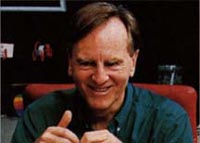 Over the next few months,Apple was forced to
lay off a fifth of its work force, some 1,200
employees. Thecompany also posted its first
quarterly loss. All this, and the resignation
ofJobs, served to erode confidence in Sculley's
abilities as CEO of Apple.
Over the next few months,Apple was forced to
lay off a fifth of its work force, some 1,200
employees. Thecompany also posted its first
quarterly loss. All this, and the resignation
ofJobs, served to erode confidence in Sculley's
abilities as CEO of Apple.
At the same time, Sculley became locked in a battle with Microsoft's Bill Gatesover the introduction of Windows 1.0, which had many similarities to the MacGUI. Gates finally agreed to sign a statement to theeffect that Microsoft would not use Mac technology in Windows 1.0--it saidnothing of future versions of Windows, and Gates' lawyers made sure it wasairtight. Apple had effectively lost exclusive rights to its interface design.This would prove an to be important document in future lawsuits between Appleand Microsoft, involving the Windows interface.
What brought Mac out of the hole were the twin introductions of the LaserWriter,the first affordable PostScript laser printer for the Mac, and PageMaker, one ofthe first Desktop Publishing programs ever. These two in tandem made the Mac anideal solution for inexpensive publishing, and the Mac became an overnightsuccess again over night.
In 1987, Apple introduced the Mac II. Built withexpandablity in mind, the Mac II made the Macintosh line a viable, powerfulfamily of computers. Apple was a "Wall Street darling" again, (RollingStone) shipping 50,000 Macs a month. It seemed in 1989 that Windows would be aflop, and the Mac would be riding high for the next decade.
It didn't. By 1990 the market was saturated with PC-clones of every conceivableconfiguration, and Apple was the only company selling Macs. In late May,Microsoft rolled out Windows 3.0, which could run on virtually all of thePC-clones in the world. Apple was in trouble.
Apple's top idea for a solution was to license the Mac OS. While many believedit would erode the quality of the Mac, or that it would create even morecompetition, it was becoming clear that Apple could not provide both thehardware and the software to drive an industry. There was also talk of portingthe OS to run on Intel-based machines.
It was Michael Spindler, Apple's new COO, who nixed the idea, saying that it was"too late to license."
In late 1991, Apple released its first generation of PowerBooks,which were an instant success. Work was being done on a new type of computer,the Personal Digital Assistant (PDA), which Apple called the Newton. Sculleytook an immediate interest in the Newton, and drove the Newton to completion inAugust 1993. The first generation of Newtons had extremelypoorhand-writing recognition, and were received very poorly.
Sculley began to lose interest in the day to day operations of Apple. Eventuallythe Apple Board of Directors decided they'd had enough. In June of 1993, Theyrelieved Scully of his position as CEO, putting Spindler in the big chair.Sculley remained with the company as chairman for several months and thenresigned.
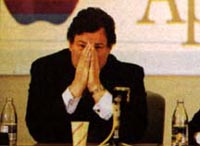 Spindler ended up being the wrong guy for the
job. A fairly impersonal man,Spindler's office
was nearly impossible to get into. However, in
his two and ahalf years as CEO, Spindler
oversaw several accomplishments.
Spindler ended up being the wrong guy for the
job. A fairly impersonal man,Spindler's office
was nearly impossible to get into. However, in
his two and ahalf years as CEO, Spindler
oversaw several accomplishments.
In 1994 Apple announced thePowerMacfamily, the first Macs to be based on the PowerPC chip, an extremely fastprocessor co-developed with IBM and Motorola. The PowerPC processor allowed Macsto compete with, and in many cases beat, the speed of Intel's newer processors.
Spindler also managed to license the Mac OS to several companies, includingPower Computing, the most successfulMac-clone maker to date. But many believe the Apple was too restrictive in itslicensing agreements, and only a handful of companies have licensed the Mac OSso far.
But Apple's worst problem wasn't selling computers--it was building them. ByJune 1995 Apple had $1 billion dollars in backorders--and did not have the partsto build them. Apple's problems were added to by the late-summer release ofWindows '95, which mimicked the Mac GUI better than ever.
Apple took its worst plunge ever in the winter of 1995-96. Misjudging themarket, Apple pushed low-cost Performas overmid-range PowerMacs, and failed to make a profit at all. Apple posted a $68million loss for that quarter. In January 1996, Spindler was asked to resign asCEO and was replaced by Gil Amelio, the former president of NationalSemiconductor.
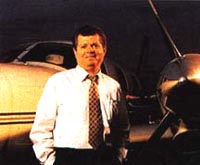 Amelio made a strong effort to bringApple back
to profitability, but his efforts would prove to be
largely unsuccessful. Following his first 100 days
as CEO, Amelioannounced broad changes in the
corporate structure of the company. The
companywas to be split into 7 separate divisions,
each responsible for its own profitor loss. He has
also made an effort to keep developers and
customers betterinformed about the day-to-day
affairs of the company. Although the companyannounced a staggering $740 million
loss for Q1 1996, they brought that lossdown to $33 million for Q2, beating all
estimates by the best financial experts.In Q3 Apple profited nearly $30 million,
again astounding financialexperts, who had predicted a loss of as much. (Apple
lost considerably more in Q4.)
Amelio made a strong effort to bringApple back
to profitability, but his efforts would prove to be
largely unsuccessful. Following his first 100 days
as CEO, Amelioannounced broad changes in the
corporate structure of the company. The
companywas to be split into 7 separate divisions,
each responsible for its own profitor loss. He has
also made an effort to keep developers and
customers betterinformed about the day-to-day
affairs of the company. Although the companyannounced a staggering $740 million
loss for Q1 1996, they brought that lossdown to $33 million for Q2, beating all
estimates by the best financial experts.In Q3 Apple profited nearly $30 million,
again astounding financialexperts, who had predicted a loss of as much. (Apple
lost considerably more in Q4.)
In late december 1996, Apple made an industry-shattering announcement: That it would be acquiring NeXT, and that Steven Jobs would be returning to the fold. The merger was brought about in order to acquire NeXTstep, which is to become the basis for Apple's next-generation OS, Rhapsody, slated for a 1998 release. Rhapsody is to be nearly platform-independent, and is progressing smoothly.
The Newton department was recently spun off into a wholely-owned subsidy, Newton, Inc.
In early July 1997, Apple announced the resignation of Gil Amelio, following a $740 million second quarter loss. This came as a surprise to nearly everyone, and at this time a new CEO has yet to be announced. The Executive Board reportedly felt that Amelio had done all he could for Apple, and that while he had been responsible for a number of improvements at Apple, he could do no more. In the meantime Fred Anderson, Apple's CFO, has been put in charge of day-to-day operation, and Steve Jobs has been given an "expanded role" at Apple for the interim.
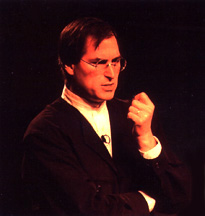 Jobs' presence was known almost as quickly as NeXT was acquired. The
degree of Jobs' "expanded role"soon became quite clear. With noCEO and
Apple Stock lower than it had been in 5 years, there were many decisions to be
made,and not much time to make them. Jobs beganto make striking changes in the
structure of Apple, including the canceling of the Newton spin-off.The time and
place for the most ground breaking announcements, however, would be
MacWorld Boston inAugust 1997.
Jobs' presence was known almost as quickly as NeXT was acquired. The
degree of Jobs' "expanded role"soon became quite clear. With noCEO and
Apple Stock lower than it had been in 5 years, there were many decisions to be
made,and not much time to make them. Jobs beganto make striking changes in the
structure of Apple, including the canceling of the Newton spin-off.The time and
place for the most ground breaking announcements, however, would be
MacWorld Boston inAugust 1997.
Jobs, who by now was being referred to as "interim CEO," made the keynote speech, and spoke of thecompany's upcoming aggressive advertising campaign, upcoming new macs, and Rhapsody. He alsoannounced an almost entirely new Board of Directors, including Larry Ellison, CEO of Oracle.But he saved the best for last. In a ground breaking decision, Jobs announcedan alliance with Microsoft. In exchange for $150 million in Apple Stock, Microsoft and Apple wouldhave a 5-year patent cross-licence and, more importantly, a final settlement in the ongoing GUIargument. Microsoft agreed to pay an unreleased sum of additional funds toquiet the allegations that it had stolen Apple's intellectual property in designing its Windows OS.Microsoft also announced that Office '98, its popular office package, would be available for the Macby years end.This was quite a lot of fireworks, but Jobs was not finished. There was one more big obstacle totackle: Clones. Jobs felt that Clone Vendors such as Power Computing were cutting into Apple's high-end market, where they traditionally made the most profit. Clones had failed to effectively expand the MacOS market, instead taking customers away from Apple.Jobs remedied this apparent failure of the Clone experiment by all but pulling its plug. In earlyFall 1997, Apple announced its intention to buy out Power Computing's MacOS license, and much of its engineering staff. Power would move to the Windows market, with Apple taking over its product support. Apple also bought out its MacOS licences from Motorola and IBM. Umax was allowed to stay in the game, butwith the tacit understanding that it would fill the low-end market, with machines selling for under$1000.
On November 10, 1997, Apple held another press conference, in which Jobs announced further changesto Apple's corporate strategy. Apple would now sell computers direct, both over the web and the phone, asPower Computing had done so well in the past. Jobs also announced two new Apple machines:the PowerMac G3, and the PowerBook G3.
The Apple Store was a runaway success, and within a week was the third-largest
eCommerce site on the web. At MacWorld San Francisco in January, Jobs
announced that Apple had, for the first time in more than a year, had a profitable
First Quarter--to the tune of $44 Million.This far eclipsed analysts' projections,
and sent Apple's stock back into the 20s. In late March, Apple released the
PowerMac G3 All-In-One, a radical redesign of Apple's previous all-in-one
offerings, to the educational market. In April, Jobs announced another profitable
quarter ($57 Million), which cameas a big surprise to nearly everyone. Jobs kept
momentum moving, and in early May announced a new PowerBook G3, an
Educational Apple Store, and an entirely new Mac design--the iMac. The iMac
would be Apple's answer to the low-end consumer question, with more than
enough computing powerfor most people, at an affordable price. Later that month,
in his keynote at the WWDC, Jobs announced a dramatic shift in Apple's OS
direction. Mac OS X would merge OS 8 and Rhapsody--Apple's upcoming
version of NeXTStep--into one robust OS, with all the features of a modern OS
and backward compatibility with most OS 8 applications. Jobs continuesto be
referred to as the "Interim CEO" of Apple, but most are now assuming he will stay
on as long as it takes to make Apple the company it can be..
![]()